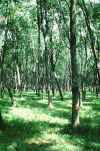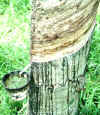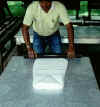Rubber Production: Tapping rubber trees, latex collection and
processing of raw rubber.
Many plants produce latex, which oozes from cuts and injuries as a milky
sap. Special cells called laticifers produce latex. In general, latexes have a
biological function in herbivore defense and/or laticifers are a dumping ground for
metabolic by-products or reservoirs of biosynthetic materials. All latexes are
emulsions, aqueous suspensions of insoluble materials which can include alkaloids,
terpenes, resins, phenolics, proteins, sugars, and long-chain hydrocarbons. Not all
latexes are elastic; those that are contain long-chain hydrocarbons. Some latexes
are collected for their resins or their alkaloids (opium).
Rubber is a coagulated, elastic latex. Plants that produce elastic
latexes are largely neotropical. Commercial rubber is produced from latex of Hevea
brasiliensis. The water proofing and elastic properties (rubber balls) of
various rubber producing plants were discovered by native American cultures, the Aztecs or
earlier mesoamericans, and South American tribes.
Orginially collected from wild trees in South America, now 90% of rubber
production comes from plantations of rubber trees in Southeast Asia. The following
images will show you rubber tree tapping, latex collection and processing from an
experimental plantation in southern Thailand.
 A rubber tree
plantation in southern Thailand. |
 Each night a new cut is
made causing a new flow of latex. |
 Latex flow begins. |
 Latex flows toward a
collection cup. |
 Latex begins to flow
into the cup. |
 Latex being coagulated in
a pan. |
 Water
is rolled out of the cake of fresh rubber. |
 Fresh and smoked sheets
of raw rubber. |
Return to Course & Plant Photo Essay
Page
Return to Armstrong's Main Page







